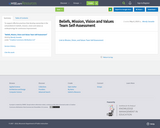
To support effective practices that develop ownership in the school/district’s beliefs, mission, vision and values as underpinnings for continuous improvement.
- Subject:
- Education
- Material Type:
- Other
- Self Assessment
- Date Added:
- 05/08/2018

To support effective practices that develop ownership in the school/district’s beliefs, mission, vision and values as underpinnings for continuous improvement.
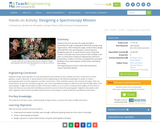
Students find and calculate the angle that light is transmitted through a holographic diffraction grating using trigonometry. After finding this angle, student teams design and build their own spectrographs, researching and designing a ground- or space-based mission using their creation. At project end, teams present their findings to the class, as if they were making an engineering conference presentation. Student must have completed the associated Building a Fancy Spectrograph activity before attempting this activity.
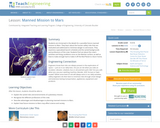
This lesson will discuss the details for a possible future manned mission to Mars. The human risks are discussed and evaluated to minimize danger to astronauts. A specialized launch schedule is provided and the different professions of the crew are discussed. Once on the surface, the crew's activities and living area will be covered, as well as how they will make enough fuel to make it off the Red Planet and return home.
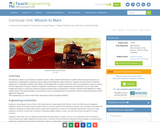
The Mission to Mars curricular unit introduces students to Mars the Red Planet. Students discover why scientists are so interested in studying this mysterious planet. Many interesting facts about Mars are revealed, and the history of Martian exploration is reviewed. Students will learn about the development of robotics and how robots are beneficial to science, society and the exploration of space. Details on engineers' involvement in space exploration are presented. Furthermore, students will learn how orbits allow astronauts to move from planet to planet and what type of equipment is used by scientists and engineers to safely explore space. Lastly, the specific details on and human risks for a possible future manned mission to Mars (and back to Earth again!) are discussed.
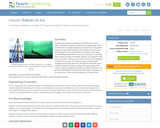
Students learn about humankind’s search for life in outer space and how it connects to robotics and engineering. NASA is interested in sending exploratory missions to one of Jupiter’s moons, Europa, which requires a lot of preparatory research and development on Earth before it can happen. One robot currently being engineered as a proof of concept for a possible trip to explore Europa is the Icefin, which is an innovative robot that can explore under ice and in water, which are the believed conditions on Europa. This lesson provides students with intriguing information about far off (distance and time!) space missions and field robotics, and also sets up two associated robotics and arts integration activities to follow. The lesson can be used individually to provide new information to students, or as a precursor to the associated activities. A PowerPoint® presentation and worksheet are provided.
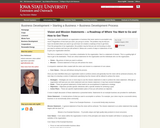
Article describes the importance of creating organization goals, vision, and mission statements